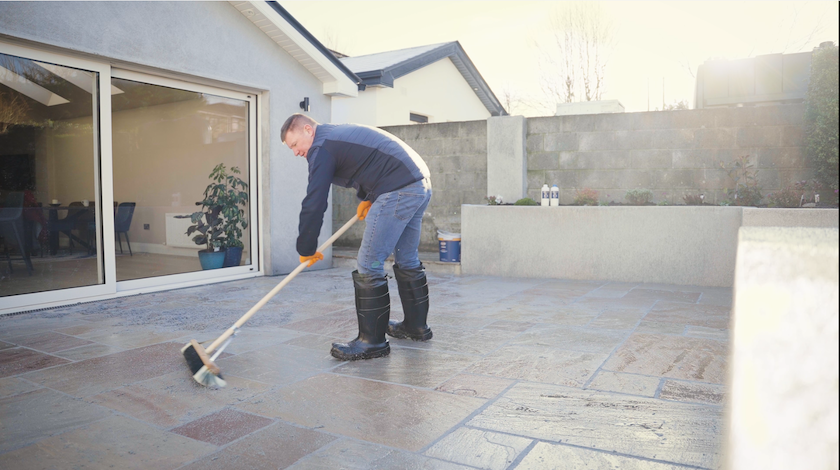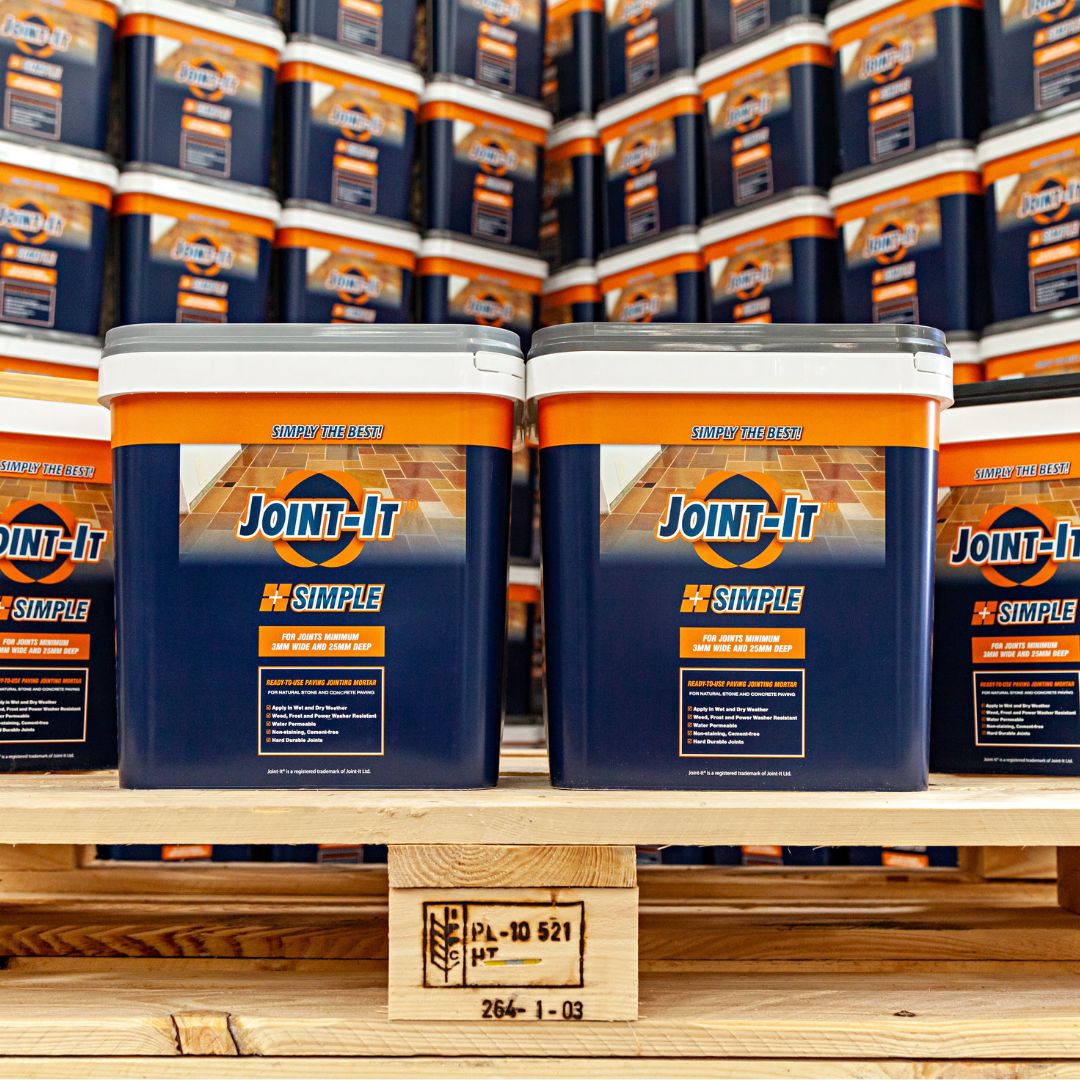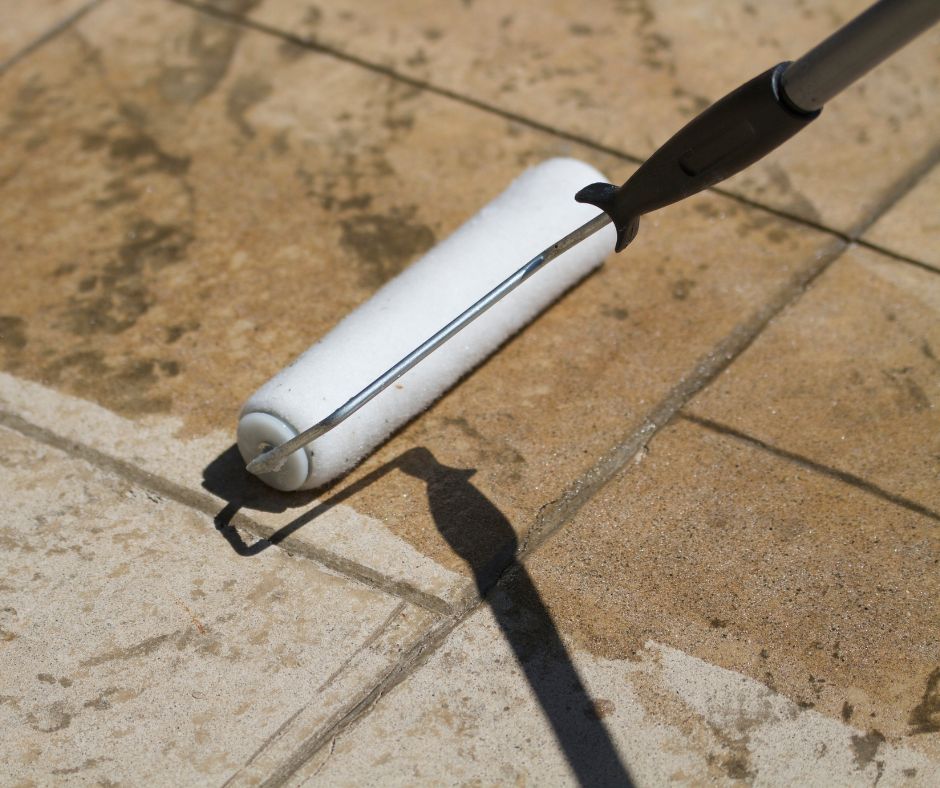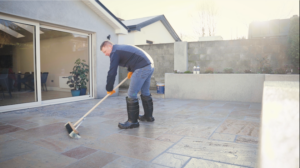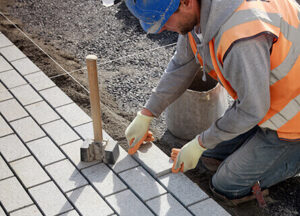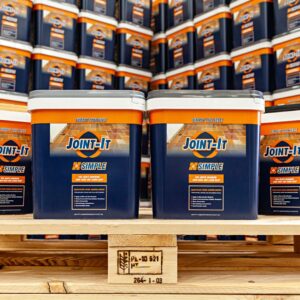Laying paving slabs for the first time? It’s important to do the groundwork to avoid any paving problems and ensure your new patio has the durability and longevity you desire. Follow these eight essential steps on how to lay a patio like a professional.
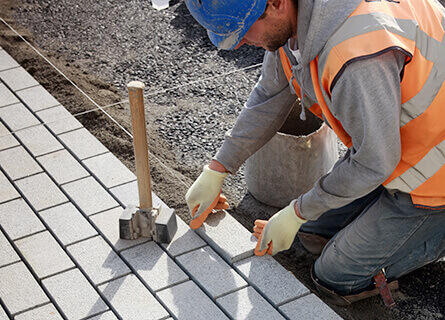
This step-by-step guide has been written for those new to laying patio paving. But if you have laid one or two patios in the past, there’s no harm in brushing up on the dos and don’ts of paving construction.
If you’ve employed a paving contractor to do the job, you will still find this advice useful as it will help you familiarise yourself with the process of paving installation. It will inform you enough to ask the right questions and check the quality of the job.
Specifically, this paving advice can be used for laying the following types of paving materials:
- Porcelain paving
- Natural stone paving, such as limestone, sandstone, granite or slate
- Concrete paving
8 essential steps for laying a patio
When laying a patio, you should follow these essential steps:
- Measure up and calculate materials required
- Mark-out your patio
- Excavate to the required depth (usually 250mm)
- Lay and compact the aggregate sub-base
- Install the bedding layer
- Prime and lay the pavers
- Wait for the bedding layer to set
- Grout the joints and allow to cure
Read on to uncover in-depth instructions for each of these steps to achieve a long-lasting patio project, together with the tools and materials required.
Tools required to lay a patio
When installing a patio, you will require the following tools and equipment:
- Tape measure
- String line and stakes/pegs
- Builder’s folding square or right-angled triangle
- Spade or shovel
- Spirit level
- Rubber mallet
- Rake
- Wheelbarrow
- Spray paint (optional)
- Wacker plate or roller
- Cement mixer (optional)
- Bucket or flexi-tub
- Wet saw, grinder and diamond blade (for cutting paving slabs to size)
- Access to clean water
Depending on which type of grout you use, you may also need some or all of the following tools for grouting the newly laid patio:
- Trowel
- Broom
- Sponge
- Pressure washer
- Washboy bucket or electric sponge machine
- Long-handled squeegee
Materials and supplies needed
The following paving materials are required to install and finish a patio:
- Paving slabs
- MOT Type 1 aggregate for the sub-base
- Bedding mortar or a sand/cement mortar mix
- Priming slurry
- Paving grout
- Paving sealant (optional, for natural or concrete pavers)
- Grout residue remover (if necessary)
- SBR bond (optional)
The 4 layers of a patio
A professional patio consists of four layers.
Starting from the bottom, it features:
- Subgrade or substrate – excavated to allow space for the height of the sub-base, mortar bed and paving slabs
- Sub-base – compacted MOT Type 1 aggregate
- Mortar bed or laying course
- Paving slabs
Step 1: Measure-up and calculations
First thing’s first, you’ll need to measure the area earmarked for the new patio.
Once you have the exact measurements you can then calculate how many paving slabs are required and the amount of other materials that will be needed.
Calculate the area of the patio
Measure the two dimensions of the area in metres and multiply them together to calculate the coverage of the area in square metres (m2).
Patio area (m2) = width of area (m) x height of area (m)
Once you know the square meterage, you can then calculate how many paving slabs are required and start estimating the total cost of the project.
Calculate the amount of paving required
When calculating how many paving slabs you will need, it is always best to add 10% as a contingency for any breakages and cuts that are required.
Paving slabs = patio area (m2) + 10% as a contingency
Next, you’ll need to calculate the amount of sub-base aggregate, mortar mix, primer and grout required for the job.
Calculate the gradient of the patio
Most patios require a gentle slope to allow surface water to easily drain away.
For non-permeable projects, this tends to be calculated using a 1:80 gradient, making a 1 unit fall for every 80 units of paving. If extra assistance with drainage is required, you could use a ratio of 1:60.
Gradient fall in mm = length of paved area (in mm) ÷ 80 (or the required gradient)
Always apply the gradient in the direction you want the surface water to drain.
Permeable paving projects don’t necessarily require a gradient. Puddling should not occur as any surface water should soak through the pavers and/or joints into the ground below.
Saying that, if your patio is on a sloping site, the maximum gradient for permeable paving to function is 1:20. If the slope is any steeper, the water will simply run over the paving surfaces rather than infiltrate into the ground.
Calculate the amount of sub-base required
Estimate the amount of MOT Type 1 sub-base aggregate you will require by multiplying the patio area by the depth of aggregate, and then multiplying that by 2 to get the tonnage required.
Sub-base aggregate (tonnes) = (patio area (m2) x depth of aggregate (mm)) x 2
Note: 1 tonne is equivalent to 1000kg
The aggregate sub-base should be laid and compacted to a depth of 100mm, but more on driveways. If the patio will feature a gradient, you’ll need to also consider this in your calculations.
What is MOT Type 1?
The final calculations are for estimating the amount of bedding mortar, grout and other supplies you’ll need.
Choosing a bedding mortar
Bedding mortar can be a 5:1 ratio mix of sharp sand to general purpose cement.
However, many professional landscapers opt for ready-made and high-strength bedding mortars due to their ease of application (just add water and mix), fast-setting nature and the extra guarantees that come with a refined and tested product.
There are a variety of different off-the-shelf mortar mixes that can be used for different projects. For example, permeable mixes for permeable projects or specific mortars for certain types of paving slabs.
Explore bedding mortars
Online calculator tools are available for each of these bedding mortars so you can easily estimate how much mortar you require for the job.
All of these mixes come in 25kg bags and require a paddle mixer.
Note: Fuga-Pave Hybrid Bedding Mortar Mix is an additive. Mix it with sand at a 7:1 mix ratio.
Choosing a paving grout
Paving grouts, otherwise known as jointing compounds, are required to secure paving slabs in place, minimise movement, stop weed growth and avoid pooled water in the joints.
Cement-based slurry grouts
Slurry grouts are robust, fast-setting grouts used for long-lasting paving constructions. Not suitable for permeable projects.
Permeable brush-in grouts
Brush-in grouts are easy to apply and still offer longevity and weed-free joints. Not suitable for driveways.
Epoxy resin grouts
Epoxy grouts offer an even higher bond than concrete tensile strength.
Some are suitable for permeable projects, notably Joint-It Dynamic that can be used on for grouting both permeable and non-permeable beds.
Step 2: Mark out your patio area
Using stakes or pegs, mark out the area of your new patio. Run a string line between each of the stakes to mark the edges and highest surface level of the patio.
You may want to use a right-angled triangle to ensure the corners run at 90º.
Damp proof coursing?
If the patio is being placed next to your house, the string line must be at least 100mm lower than the damp proof course to ensure the patio does not cause issues with your property’s damp protection.
Step 3: Excavation
Now it’s time to excavate the area according to your stakes and markings. Any excavation must be free of bumps, lumps and dips.
Usually around 250mm needs to be excavated. However, it’s crucial to calculate exactly how much you need to excavate based on your choice of paving slabs, firmness of the underlying soil (if it is loose it will compact further with the weight of the patio) and the intended use of the area.
When calculating how much ground to excavate, you must account for:
- Sub-base (MOT Type 1) – 100mm minimum (more for a driveway)
- Bedding layer – 30–40mm (check the mortar mix for advice)
- Depth of the paving slabs minus 5–15mm to account for it being tamped down into the bedding layer
If you are incorporating a slope, excavate to the lowest required fall at the end of the drainage run. Use stakes at 1-metre intervals to mark the gradient of the fall and show the required depth to compact the sub-base to (more on that in a moment).
If the ground is soft and clay-based, you may need to use a geotextile to stop the aggregate from blending into the ground below.
Step 4: Lay and compact the sub-base
Once the area is excavated, you then need to lay and compact the aggregate sub-base of MOT Type 1 to provide a secure and stable foundation for your patio.
Install the sub-base in layers and according to the gradient line. Use a plate compactor (sometimes called a wacker plate) to fully compact the aggregate and ensure the structure is stable.
Step 5: Lay the mortar bed
Install the mortar bed using your preferred mortar mix, whether that is a mix ratio of 5:1 sand to cement or a ready-made formula. Add the required amount of water.
If you are making your own mortar, you should ensure the mix is pliable and firm so it holds its shape when trowelling on top of the sub-base.
If you are using an off-the-shelf bedding mortar, simply add the specified amount of water to the mix.
Mix with a paddle mixer in a bucket until you achieve a smooth consistency. If you are working on a larger patio project, you may want to invest in a cement mixer to save time on this step.
Apply the mortar mix to 30–40mm – or to the depth recommended on the packaging.
Ensure the mortar bed is level according to the gradient. You must achieve an even surface free of any voids so that each paver will be in full contact with the bed below.
Read on for extra tips on creating a full-contact mortar bed and why achieving one is so important.
Step 6: Prime and lay the paving slabs
Use a primer – otherwise known as a bonding mortar – to add a strong adhesive layer to the back of each paving slab. Priming is an essential step for securely adhering pavers to the bedding layer below.
By using a primer, you will reduce the likelihood of slippage and movement. Fully primed pavers are also less likely to develop unsightly stains or efflorescence.
Explore paving primers
Popular bonding mortars for securing paving slabs in place.
Always add a liberal and even amount of primer across the entire underside of each paving slab before laying them.
Starting at one corner of the patio area, lay each primed paving slab 20mm into the bedding mortar and tamp into place using a rubber mallet. Allow a set gap for the jointing mortar – anything between 2–15mm.
Work from one corner of the new patio, priming and laying each slab as you go. A vacuum suction lifter is a handy tool for lifting pavers and positioning them with precision.
It is generally recommended to trowel the bedding layer mix into peaks before placing a slab down. Then, when tamping down the slab you will ensure that mortar mix spreads to cover each part of the underside of the slab and is in full-contact with the bed below.
Why is a full-contact mortar bed important?
Problems with patios can originate from failing to install pavers on a full-contact mortar bed.
Any voids between patio slabs and the mortar bed can cause the following issues, many of which cannot be remedied:
- Paving discolouration or stains through water, subsidence or patio instability
- Damaged slabs through water that freezes and thaws
- Cracks and fractures due to poor support
- Unstable slabs and trip hazards
Step 7: Wait for the bedding layer to set
Once the patio is laid, the pavers are left so the mortar bed can cure.
Bedding layer curing time can take anything from 24 hours to 28 days depending on the weather and ground conditions.
Specialist bedding mortars, such as Eco-bed and Prem-Bed, set much more quickly. Always follow the instructions for your chosen product.
Important: Never walk on paving slabs while waiting for the bedding layer to set.
Step 8: Grout the joints and allow to cure
Finally, choose your chosen grout material to fill the joints and fully secure the slabs in place.
Some grouts require you to wet the area before application to stop the jointing material from sticking to – and potentially staining – the paving slabs.
Any excess grout must be cleaned off immediately before it dries.
The patio is ready to be walked on once the grout has fully cured. Curing time depends on the grout and weather conditions, and can be anything from 1 hour (with UltraScape’s Flowpoint grout) to up to 3 days.
Always follow the instructions on the grout materials. We have a wealth of advice on using certain grouts in our News and blog.
Common questions
Laying the right foundations for paving is essential for creating a patio with a professional and flawless finish. Uneven, sagging pavers, cracks in slabs, porous stains and weed growth are all signs of poor underlying groundwork.
When preparing the ground for paving, it is recommended to:
- Measure up and calculate supplies required
- Mark out the area of your patio
- Excavate to the required depth and gradient
- Lay and compact the aggregate sub-base
- Install the bedding layer prior to laying pavers
Lay a minimum of 100mm of MOT Type 1 aggregate for stability (more for a driveway), together with a bedding layer of 30–40mm of mortar mix.
Mortar mix can be a 5:1 ratio of sand to cement. For a formula with guaranteed longevity and durability, choose an off-the-shelf mortar mix such as UltraScape Eco-Bed or, for permeable projects, Perma-Bed.
Laying a patio on unprepared soil is not recommended. Over time, the ground will shift and create an uneven surface, causing pavers to sink, crack and potentially break. Weed growth is also likely to be a problem.
For a stable patio with longevity, lay pavers on excavated ground filled with a compacted sub-base aggregate (100mm minimum of MOT Type 1) and a bedding mortar of 30–40mm. A slurry primer for the bottom of the pavers is strongly advised on by professionals to secure pavers in place and avoid stains and efflorescence.
Whether you need to add a membrane below the sub-base really depends on the quality and compaction of the ground in your garden.
A geotextile membrane may be required if the ground is soft and clay-based. This is to stop the aggregate sub-base (MOT Type 1) from blending into the ground below.
Dry laying a patio is basically a trial run of laying the patio before installing the bedding mortar and primer. This dry run-through will help you test the laying pattern and ensure your measurements are correct.
If your slabs feature tone or colour variations, dry laying allows you to test the best colour blends and mixes before laying them for real. Number the underside of the slabs so you can replicate the patterns when it comes to the wet lay.
Whether you seal your patio or not ultimately depends on the type of paving materials you’ve used and whether they are prone to stains. But another reason for sealing a patio could be to enhance the colour or the finish.
Porcelain paving is non-porous and waterproof, making it much less prone to developing stains through absorbing water.
Unsealed natural stone and concrete are porous materials that can allow water to be absorbed. Due to their porous make-up, accidental spills, efflorescence, iron staining, organic stains, and general wear and tear can all cause problems.
Sealing pavers will help to protect natural and concrete pavers from blemishes and stains. Depending on the type of pavers, you may need to wait a few months before applying a sealant, allowing enough time for any efflorescent salts to naturally develop through the stone.
Important note: While we have incorporated expert tips and industry guidance into this blog article, each patio installation varies and the advice may not be suitable for all situations. Use this information as a guide at your own risk. We strongly recommend consulting with a professional landscaper for expert advice on the ground conditions, which materials to use and design ideas for your project. Always adhere to local building codes and regulations.

